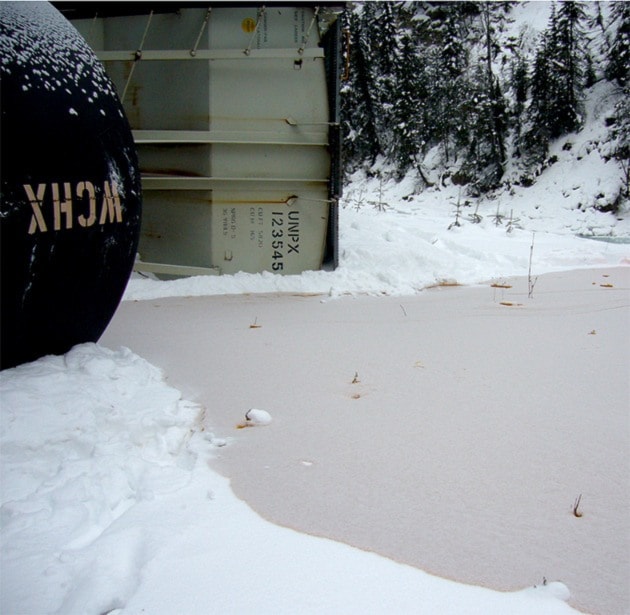Opinion, by Aaron Orlando. Revelstoke Times Review editor
I spent a considerable amount of time over the past weeks trying to find out what really happened at a train derailment near Golden on Jan. 8.
I was tipped off by local railroaders about the incident on Jan. 9, and filed a report later that day, after putting an extensive list of questions to Calgary-based CP Rail spokesperson Kevin Hrysak, and Regional Senior Investigator for the Transportation Safety Board of Canada James Carmichael. Neither of them had attended the scene of the crash, which is about eight kilometres east of Golden, B.C.
It happened in a particularly sensitive section of the railway. The line weaves through tunnels and over bridges at the bottom of the Kicking Horse Canyon, right at the shore of the Kicking Horse River. At the location where the incident occurred, the downhill grade flattens out, requiring a shift in braking. There is a small tunnel right next to the river.
In my report, I stated the following: “Hrysak said the train wasn’t carrying any hazardous materials, such as oil, liquid petroleum gas, explosives or hazardous chemicals.”
It wasn’t long before that was in dispute, and many other facts associated with the report.
I followed up with the B.C. Ministry of Environment, who did send an employee to the site. Their version of the incident differs somewhat.
CP Rail reported six cars derailed, but the B.C. Ministry of Environment said ten cars derailed, and provided an itemized list of the cars. Hrysak said that two of the three cars involved are “three-pack” container cars, and said the “proper reporting requirements” had been provided to government agencies. “But for formal paperwork purposes it shows that 10 cars did derail,” Hrysak wrote.
I asked Hrysak about the statement that the train wasn’t carrying “any hazardous materials, such as oil, liquid petroleum gas, explosives or hazardous chemicals.”
He replied that he meant there hadn’t been any in the derailed cars.
I reviewed the recording of our Jan. 9 interview. Here is the passage:
Times Review: “So, there was no hazardous materials on the train, there was no petrochemicals, no LNG or anything like that?”
Hrysak: “Correct.”
Orlando: “OK”
Hrysak: “That were involved.”
***
In a subsequent telephone interview, I asked Hrysak if we could find out if the train was in fact carrying any of the hazardous cargo listed above. In an email response, he said the answer was not “relevant.”
“The remaining consist [sic] is not relevant to the incident as they were not among the cars that were involved and there was no public safety concerns as mentioned,” Hrysak said.
Can you imagine, ten years from now, a tanker running aground on the West Coast, but no transportation official comes to investigate, and questions about the contents of the ship are dismissed as not ‘relevant?’
Although the 500 litres of fish oil that was spilled in the incident is benign, a B.C. Ministry of Environment spokesperson did confirm that some of it spilled into the Kicking Horse River.
***
According to a media report, CP Rail shipped 90,000 carloads of crude oil in 2013, a 68 per cent increase over 2012. CP hopes to double that again to 210,000 by 2015.
As reported in the Times Review last week, the Transportation Safety Board of Canada is recommending new safety rules for rail transport in Canada as a result of increases in crude oil shipments.
Although the differences between the information initially provided by CP on the Jan. 8 incident and what actually happened could be dismissed as semantics, the overall picture is worth noting. The Transportation Safety Board of Canada didn’t attend and is relying on reports from CP Rail for their investigation. The incident wasn’t notable mainly because it was fish oil that spilled – not whatever else that may have been on the train. The report into the incident will take months and won’t likely be made public.
Also last week, a B.C.-Alberta government working group recommended increasing the public’s “energy literacy” – a poor wording choice bound to rub many the wrong way.
Pipeline proponents have learned to leverage public fear following the Lac-Megantic disaster to present and either-or argument – either a pipeling or more oil by rail. It’s not. But we need to engage in the issue, ore we’ll end up with whatever transportation system others decide for us.
In Revelstoke, we have a lot to lose. The CP line runs next to the Illecillewaet River, which runs through Revelstoke and into the Columbia. Rail accidents happen – like the raging fire that nearly destroyed the bridge over the Columbia River last May.
Where do we look for guidance on this multi-faceted, developing issue? Revelstoke has a leader on the rail safety file in Revelstoke City Councillor Gary Starling, and we should heed him. He’s a recently-retired railroader who has been increasingly vocal about rail safety issues. If we don’t follow those who take a lead, their ability to be effective is diminished.
He warns of a culture shift at CP Rail that places the emphasis on profit – and the new CEO Hunter Harrison would agree, announcing record annual profits last week to mark his his first full year in charge of the railway.
